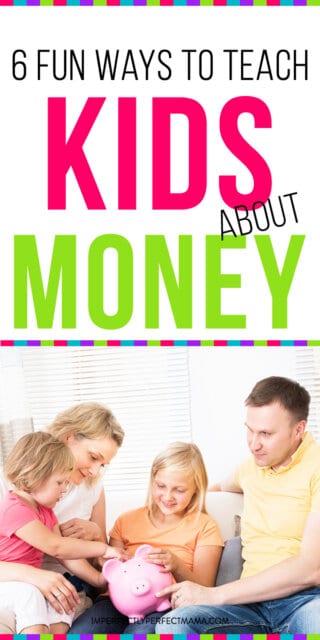Did your parents teach you about money basics as a child or was money a non-topic in your household?

When my husband and I got married ten years ago, we didn’t realize that we had two very different financial educations from our parents growing up.
Because of this, we had differing strategies and viewpoints on managing money and smart finances.
About 5 years into our marriage, we were $100,000 in debt and wanted to get serious about paying it off.
As we set out on our debt-free journey, we had a lot of conversations about how we could help our children avoid the same pitfalls we had experienced.
Even though our kids are young, we decided to start introducing basic money concepts early on to teach the fundamentals that will hopefully set them up for success in the future.
We wanted to make it fun and practical so it didn’t feel like we were just talking AT them.
So, no repetitive coin counting and boring financial conversations necessary!
6 Fun Ways to Teach Kids About Money
1. Get a Clear Coin Counter
Instead of getting a traditional piggy bank, you can purchase a clear coin counter for your kids to save their money. Every time they find a coin on the ground or earn money doing chores, they add their money to their coin bank.
This is a simple way to give kids the visual experience of what it looks like to save money as the coins fill up the coin bank.
It’s also an amazing way to teach the value of individual coins and how they add up by using the coin counter. When they add a penny versus a quarter, they can see how that impacts their total amount saved.
Kids get a lot of pride over showing off their savings as they watch their bank fill up and their total rise.
2. Play Money Games

Playing games that include money is a simple and practical way to introduce the idea that the things we buy have a monetary value, and we have to give away our money to get something in return.
We live in a world where most people pay for things with debit and credit cards, so the trading of money for products and services is not SEEN by our kids. Every purchase looks like a simple swipe of a card or push of a button.
Games are a fun way to talk about how there is actual money on those cards.
Some of my favorite money games for kids are:
- Monopoly Junior
- The Game of Life Junior
- Pay Day
- Money Bags
3. Show Your Budget and Expense Tracker
This doesn’t sound like it would be fun for kids, but I’ll tell you that you will probably be surprised at how interested your kids will be.
My kids were absolutely shocked when they found out we had to pay someone for our house and utilities.
Depending on your comfort level with sharing actual numbers with your children, you can show them money coming out of your bank account online, or you can show them your budgeting system and how much money goes to each category.
This is a great way to show kids why we work as adults, how much of our money goes towards necessities, and how we make room for the extras and fun stuff in life.
4. Give a List and a Budget
A really fun way to share budgeting basics with kids is to give them a list of items you need from the store and a budget they need to follow for those items.
An example would be to give them a list of five items at the grocery store the next time you are shopping. Choose simple items with straight forward prices (produce is hard). If your kids can’t read quite yet, you can draw pictures of different items.
I usually give a list like this one:
- diced tomatoes
- ice cream
- broth
- tortilla chips
- shredded cheese
Then give them a budget for how much they can spend. For a list like the one above, I’ll tell them to spend $12 or less.
This is an amazing opportunity to talk through the price differences between brands and generic. It also brings up the topic of food quality and value. So many teaching opportunities with this activity!
5. Let Them Earn Money
There are differing opinions about allowance, but I always recommend giving children some opportunity to earn money.
You may choose to pay your kids an allowance or commission each week. If you prefer they learn to help out around the house without payment, choose special jobs that they can do around the house to earn money.
You can give your kids budgeting pages to add up their earnings, distribute some to savings, and track when they spend their money.
I stick my kids’ budgeting pages on a clipboard to update as needed.
6. Help Set Short- and Long-Term Goals
As all of the different money concepts start to come together, kids will be interested in using their money to buy things for themselves.
This is a great opportunity to help your kids set both short- and long-term goals. Kids love to talk about what they want to buy.
Is there something they want to save towards? What will it take for them to save enough?
How long will it take them to meet their goals? Take time to talk about immediate gratification versus patience.
Knowing their goals is a great way to guide them when you are out in daily life. If your kids bring money with them and want to make an impulse purchase, you have the opportunity to talk with them about how this impacts achieving their goals.
Start the Conversation
The answer to teaching your kids about money is truly just to START the conversation. Look for the little opportunities in life to share how you use money as a tool to live life and help others.
There is a ton of time to be serious about financial health and money in the future, so take some time to make money fun for kids.
They’re listening and watching, and you can set them up to make smart financial decisions in the future.




Leave a Reply